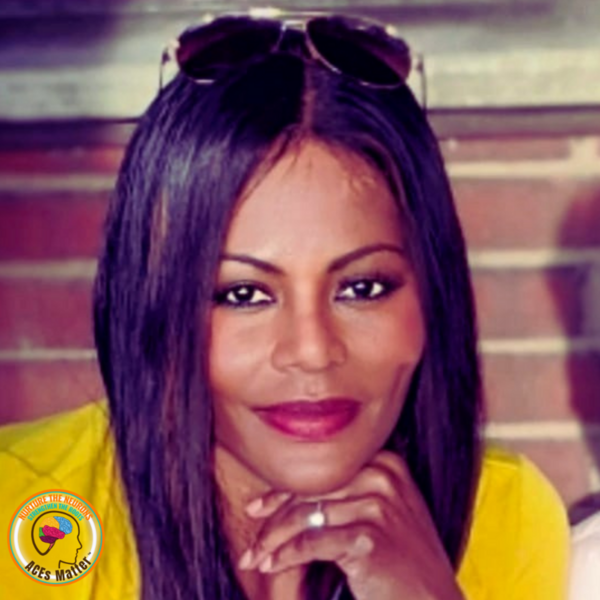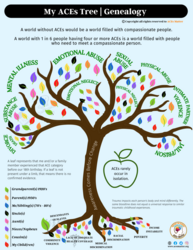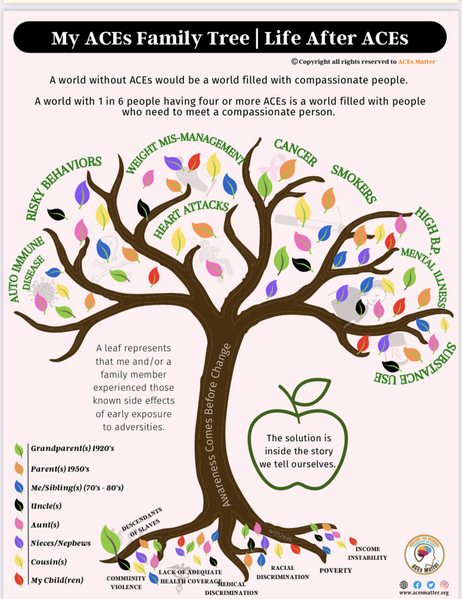This is the second of two stunning illustrations showing how adverse childhood experiences (ACEs) affected the family of Cendie Stanford, founder of the nonprofit ACEs Matter. Each leaf represents a family member affected by ACEs, and the health consequences they suffered.
When Cendie Stanford, founder and president of ACEs Matter, finished drawing “My ACEs Tree—Genealogy”—she saw clearly the remarkable number of ACEs her grandparents, parents, children and extended family had experienced. The second tree—Life after ACEs—shows how horrifically ACEs played out in their lives.
Yet when she studied the devastating stories of pain and suffering told in the tree leaves, “I felt at peace,” she says. “There was no racing in my heart. There was not a physical reaction to it, when I looked at what ACEs had done to my family, because when I think about the people who have passed, I now have a better understanding of why it happened, why they had cancer, depression, problems with weight management and risky behaviors.”
‘Everybody I know needs this.’
For Stanford, just learning about ACEs science two years ago, and the fact that her score of “10 plus” did not bode well for her future health, was enough to have her turn over a new leaf in self care. “Since I've started learning about ACEs,” she says, “I am encouraged to eat better. Meditate. Exercise. I know it’s hard for people to take on self care sometimes, because we didn’t grow up seeing people do those things. I'd never seen anybody that I know meditating.”
She knows this is not the case for many people, that “information is not transformation.” It’s not guaranteed to bring the behavior changes to give up cigarettes, fried foods, sweets, and many other comforts that, consumed habitually, may be very useful to cope with the consequences of ACEs, but are, in the long run, harmful.
She wants people in underserved communities to create a tree like this for themselves, “so they can decide whether or not they want to do something about it,” she says. “Everyone deserves to know about ACEs, so they can make choices, so they can be inspired to help improve their health; practice self care, help rewire their nervous system. So they can maybe help kids and adults learn how to be calm and become regulated without becoming violent, or looking for a cigarette, or food, or a drug or drink” she says. “Brains can change at any age, and our bodies want to heal.”
Transformation requires more than just information.
“Helping people in underserved communities work on their own genealogy by drawing their own ACEs trees may help people open up. People in vulnerable populations don’t feel like it's safe to talk about feelings. But even if these conversations can be activating, I believe being able to have people create and share their own family tree will show that we all have a lot in common, and need to take some action to improve our health. I hope we all see that not having the conversation is catastrophic,” says Stanford.
“Awareness will lead us to change. I know it is going to take some time. But what we can't do is just wait for the people in these underserved communities to come to us. Right now we have to find representatives who’ll take this information into the communities, and help people figure out how to calm these kids’ nervous systems, so kids stop killing kids. Something needs to be done so these kids learn how to self regulate, so people get healthier and live better, and longer,” she explains.
Stanford says she plans to prioritize her work in neighborhoods in the zip codes she and her ACEs Matter board of directors are in the process of identifying. “People are advertising their depression every day on social media. You can look at people's status updates and see that they are hurting,” she adds.
Her next step is to involve representatives from all types of organizations, or sectors, by taking her “ACEs trees” to business and industries as well as into the schools, faith communities, health clinics, first responders and more, in each neighborhood prioritized.
“If businesses—for example, grocery store companies—understand this (the effects of ACEs) and address it,” Stanford explains, “their employees’ productivity could be improved. They’re hiring a lot of these people who are coming to work with adversities, especially if they are in communities where there's high violence. This is affecting their workers and their shoppers. So if they focused on preventing trauma and promoting resilience, the benefits to their communities could be life-changing, and life-saving.
“Every report I read says communities need to be involved,” she continues. “And that's what ACEs Matter feels like it can do, just by giving people the tools to take ACEs awareness into the communities and start the conversation. Let's see where that goes.”
The solutions are right here.
“We need to do what PACEs Connection is talking about, to get communities invested in their people, and build PACEs initiatives in communities, because healthy people are the product of an ACEs aware, resilient community. Let's invest in these communities because the active community members can pass the knowledge down generation after generation, and stop ACEs and the bad health outcomes from being compounded generation upon generation,” says Stanford.
"I mean, the solutions are right there for us,” she continues. “We just need to make sure that everybody gets invited to the conversation, and then they get to decide what they do with the information, right?”
This is part two of a three-part series. Part one: My ACEs tree: Geneology. Part three: How positive childhood experiences, including those in the family and the community, helped her.
Next week’s illustration and story? Putting it together: At 16, Cendie endured a trauma that could have killed her. In her third illustration, she’ll share how positive childhood experiences (PCEs)—including positive community experiences—helped her go on with life, recover, and become an advocate for the science of positive and adverse childhood experiences.







Comments (3)